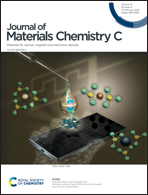Aminophosphine-derived, high-quality red-emissive InP quantum dots by the use of an unconventional in halide†
Abstract
Thanks to the synthetic maturity and environmental benignity of indium phosphide (InP) quantum dots (QDs), they have acquired a dominant position as efficient, sustainable visible emitters for next-generation display devices. High-performance emissivity of InP QDs has been achievable mostly from the use of an extremely hazardous, reactive P reagent of silylphosphine, thus demanding a search for safer, moderately reactive P precursors such as aminophosphine. Photoluminescence (PL) performances of aminophosphine-derived InP QDs become comparable to those of state-of-the-art silylphosphine-based ones particularly in green color, but this is not true for red color. In this work, we synthesize aminophosphine-based red InP QDs by adopting an unconventional In precursor of InBr3 instead of InCl3 and examine the effect of the type of surface halide, revealing that bromide is more advantageous in suppressing the surface oxidation and thus attains a brighter emissivity over chloride. Subsequently, a further improvement of InBr3-based red InP QDs toward deeper, narrower emissivity is demonstrated by the thickening of the ZnSe inner shell, resulting in a PL peak wavelength of 621 nm and bandwidth of 44 nm along with a quantum yield of 86%. These high-quality InP QDs are also tested as red electroluminescent (EL) emitters, producing promising EL outcomes in luminance and efficiency.



 Please wait while we load your content...
Please wait while we load your content...